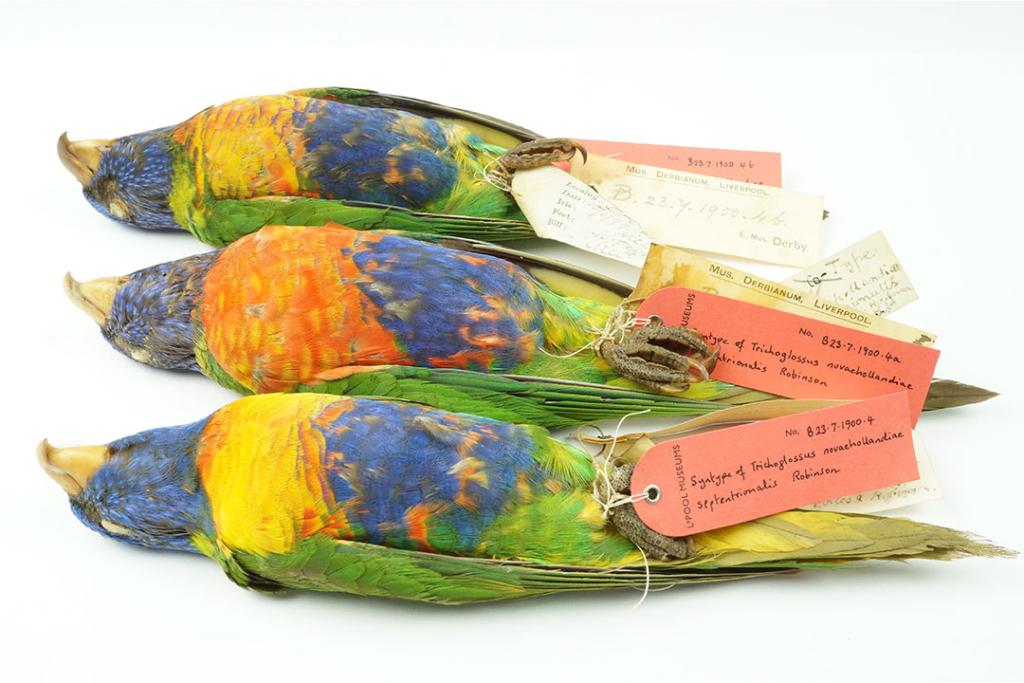Two very reserved scientists
These bird specimens in World Museum were used by scientist Hebert Christopher Robinson to describe a new subspecies of Rainbow Lorikeet in 1900. Today Rainbow Lorikeets is also the name of a group providing a safe and supportive community for LGBTQIA+ ornithologists. Take a look at why such a support group is necessary - and why it could have benefited scientists of Robinson’s generation if the group had existed a century ago - as John James Wilson explores a hidden history of inequalities.

Part of the job of a museum curator is to research the stories of specimens, objects and the people who collected or created them. In contrast to artists whose personal lives are intertwined with their public work, most scientists’ personal lives are historically underdocumented and ‘hidden’; obituaries often providing rare glimpses into lives beyond the field and lab.
Herbert Christopher Robinson and Cecil Boden Kloss are two scientists whose collections I have been researching recently. Robinson was a volunteer and assistant at the Liverpool Museums between 1897 and 1900. From 1903 to 1926 he worked as the Curator and then Museum Director of the Kuala Lumpur museum. Boden Kloss was an assistant at the Kuala Lumpur museum from 1906 before becoming Museum Director himself. The pair shared a house together in Kuala Lumpur for fourteen years. They made large collections of birds and mammals from present-day Malaysia, of which several hundred are now in World Museum.
Although we won’t ever know how these scientists identified, and whether they were part of the LGBTQIA+ community or not, passages from their obituaries nevertheless allow for some reflection on the lives of LGBTQIA+ scientists during their lifetimes and today.
An obituary in the journal 'Ibis' ends with the cold statement: “Robinson was never married”. The phrase ‘he never married’ was used factually, but also occasionally in obituaries as code to acknowledge that the deceased was gay. We will never know whether this was or wasn’t intended as code, but regardless, marital status continued to be a source of stigma and insinuation well into the 21st century.
‘Marriage and civil partnership’ is now a protected characteristic under UK equality law, but this provides no protection against negative treatment of single folks. The ‘one body problem’ of some science careers disproportionately impacts LGBTQIA+ people.
Boden Kloss was married, but his wife and stepsons don’t appear to have joined him when he moved permanently to Southeast Asia in his late 20s.

Gibbon named after Boden Kloss © Klaus Rudloff / CC BY-SA 4.0 (via Wikimedia Commons)
Ibis describes Robinson as “somewhat shy and retiring”; Nature goes further, “he was very reserved”. Likewise, the Bulletin of the Raffles Museum describes Boden Kloss as “shy and reserved” but also as “not a knowable man”, “hyper-sensitive” and “aloof”, traits attributed by the obituary’s author to insecurity due to a “foreign name” and “dark complexion”.
It is easy to imagine LGBTQIA+ scientists being described in similar ways. Even in today’s totally transformed legal (in the UK at least) and social situation minority stress means LGBTQIA+ people often feel nervous, even appearing ‘antisocial’ or introverted, particularly in unvetted company. This stress can be felt acutely during overseas fieldwork.
Robinson suffered from an undisclosed respiratory disease throughout his life. To recuperate he lived in Switzerland for a couple of years in his 20s and returned to the Alps frequently while on furlough from Kuala Lumpur. In those days sending folks away for a ‘change of air’ was prescribed for a variety of physical and social ‘ailments’.
Data obviously wouldn’t be available for Robinson and Boden Kloss’s generation, but today we know that LGBTQIA+ folks face various health inequalities, including a higher burden of cancer, mental health problems, and reduced life expectancy.

Magpie named after Robinson
Robinson’s illness didn’t prevent him from ultimately spending 25 years in the Southeast Asia tropics as “a keen an indefatigable field naturalist”. On retirement Robinson returned to England with plans to complete a book series on the birds of Peninsular Malaysia but this was unrealised and he died only three years later aged 54.
Despite systemic inequalities a few LGBTQIA+ scientists have become well-known and celebrated. There will be many more exceptional scientists associated with our collections whose personal lives remain hidden.
Lead image by Vertebrate Zoology Curator (CC BY-SA 4.0): Specimens used by Hebert Christopher Robinson to describe a new subspecies of Rainbow Lorikeet – Trichoglossus novaehollandiae subsp. septentrionalis - from Cookstown, Queensland, Australia (NML-VZ B.23.7.1900.4; NML-VZ B.23.7.1900.4a; NML-VZ B.23.7.1900.4b). Rainbow Lorikeets is also the name of a group providing a safe and supportive community for LGBTQIA+ ornithologists.
